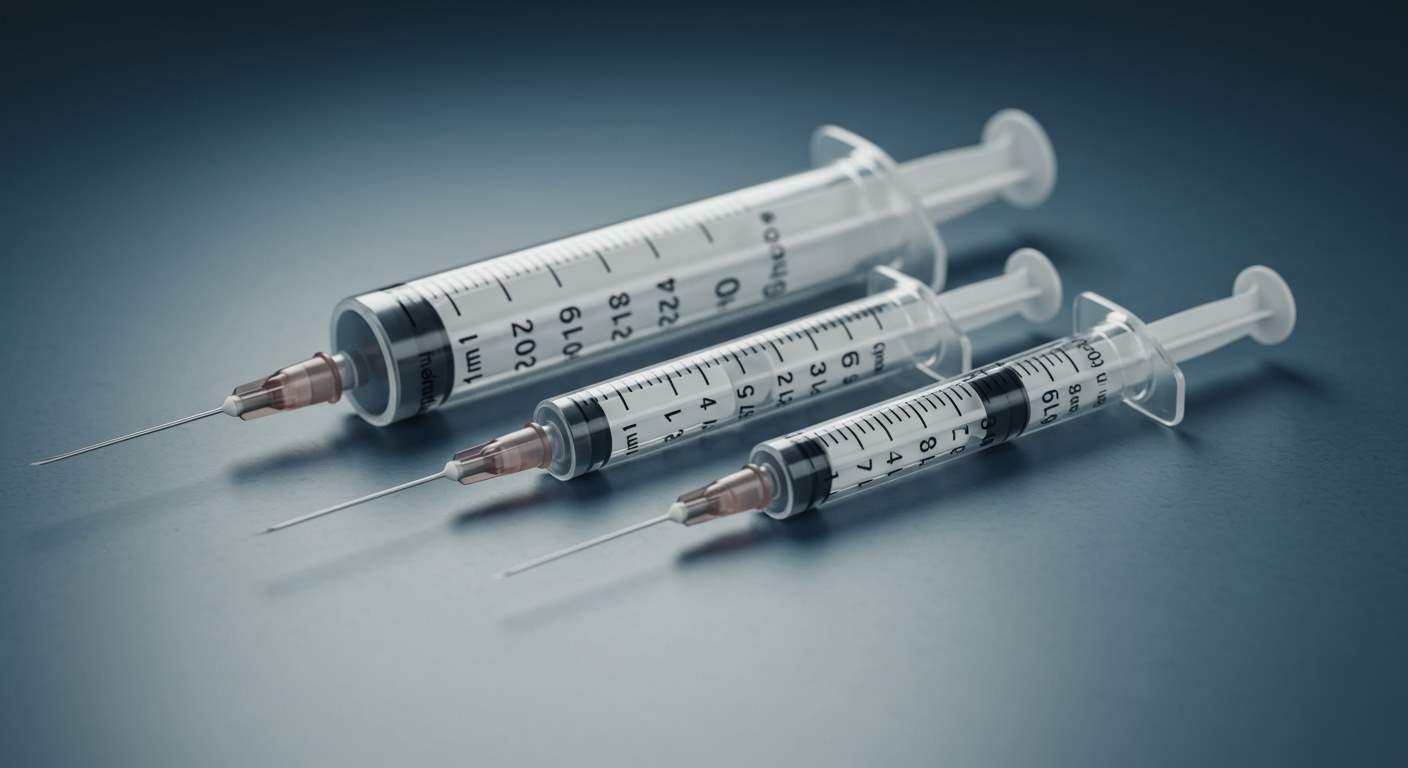All About the Syringe Barrel: A Detailed Look
Oct 24th 2025
Syringe barrels are critical in the sectors of healthcare and laboratories in the US. They are applicable in hospitals, research labs, and diagnostic centers to deliver medication and sampling. These are tools that are accurate and safe in handling and testing the liquids. According to a report by Grand View Research in 2024, the US syringe market will reach 6.5 billion dollars by the year 2030. This increase is attributed to vaccination programs, diagnostics, and increased research fields. The liquid is contained and measured in the barrel of the syringe, which is the main structure. It guarantees control, accuracy, and ease whenever in use. To learn more about syringe barrels and related tools, the user will be able to browse specific product collections, which include needles and syringes that are used both in the medical industry and for general use.

The Anatomy of the Syringe Barrel
The syringe barrel appears to be simple, but it is an efficiently engineered tool that is designed to be accurate. It is commonly made of polypropylene or borosilicate glass. These materials ensure that it is well resistant to chemicals and clear to read. Barrel aids users to measure, draw, and dispense liquids safely and accurately.
The Tip (Luer Lock vs. Luer Slip)
The tip is the point where the needle fits on the barrel of the syringe. There are two categories of tips that are given:
- Luer Lock tips are twisted to secure the needle tightly and avoid leakage. They are common in hospitals and laboratories where safety is critical.
- Luer Slip tips provide a push-fit fitting mechanism. These are perfect for applications requiring frequent needle changes.
Different syringe barrels come in both of these tip designs, depending on use and setup. Both types are found in sterile and general-purpose syringes for medical and lab environments.
The Barrel Body
The barrel body is the central part that holds the liquid. Its clear surface helps users see and measure the volume correctly. The majority of barrels are between 0.5 ml and 60 ml. The accurate syringe measurements are based on the print on the body and its clarity. These marks do not easily fade even after cleaning or sterilization. An effective syringe barrel can make frequent, reliable readings and minimize the possibility of mistakes in dosage.
The Flange
At the open end of the barrel is the flange. It helps users hold the syringe securely during operation. This grip allows better thumb control for drawing or dispensing liquids. A strong flange design is especially useful for medical dosing, lab pipetting, and fluid testing systems. The flange keeps it stable and decreases the fatigue of the hands when using it continuously.
How to Read the Markings on a Syringe Barrel
Knowledge of syringe measurements is important in proper dosing and in laboratory use. Both syringe barrels have clear lines and figures that indicate volume. These lines help medical staff and lab technicians control liquid amounts precisely. The US healthcare system places a strong focus on correct syringe readings to avoid medication mistakes. Misreading the markings can lead to under or overdosing, which can cause serious issues.
Understanding CC and ML Units
The markings “cc” and “mL” both represent cubic centimeters of volume. They mean the same and are used interchangeably in most settings. However, in the US, “mL” is more common for clinical practice. General-purpose syringe barrels frequently have dual markings for ease and making them flexible. Knowledge of such markings would provide consistency in the process of drawing liquid with a syringe in various laboratories and health institutions.
Different Types and Sizes of Barrels
Syringes come in numerous standard sizes that apply to particular uses. The correct decision is determined by the amount of liquid that should be measured/transferred.
- The barrels of small volumes (1-3 mL) are best in operations of injections and the preparation of the exact doses.
- Medium barrels (5-10 mL) are great to use in the lab and for liquid transfers.
- Large barrels (20-60 mL) are suitable when it comes to irrigation, suction or industrial use.
The syringe barrel size is appropriate to support the various types of work. For example, doctors use small sizes for injections, while labs prefer medium ones for sample transfers. Large syringe barrels are also utilized in cleaning and machinery tasks. High-tech piston type syringes permit a more fluid transfer and lower trapped air. This assists in maintaining accuracy in the transfer of liquids or in performing testing.
Proper Handling for Accurate Measurement
Proper handling of the barrel of the syringe guarantees reliable results. Even a minute error during handling can lead to measurement or contamination errors. Regular safety and maintenance procedures should always be practiced by users. To achieve optimal results, the users are encouraged to:
- It is not advisable to touch the tip of the plunger to ensure that it is not contaminated.
- Check or fill with the syringe in a vertical position.
- Eliminate all air bubbles prior to dispensing / injecting the liquid.
- Store all syringe barrels in dry and clean areas to avoid moisture and dust buildup.
According to the US Centers for Disease Control and Prevention (CDC), measurement errors can be minimized by 15% by appropriately handling them. Periodic cleaning, calibration, and checking assist in prolonging the life of the syringe barrel and ensure accuracy during regular use. To obtain reliable readings, laboratory professionals and clinicians tend to verify their syringes every time before each operation.
Why Syringe Barrels Are Important
A syringe barrel is not simply a container, but the core of the syringe. It describes the precision of the liquid which can be drawn, measured, or delivered. The accuracy of the barrel influences the performance of the syringe in general. The improperly created barrel might lead to leakage or errors in doses. The great quality of barrels retains their performance even under pressure or subsequent sterilization. In both laboratory and medical environments, safety depends heavily on this accuracy. The clear syringe barrel visibility is used to avoid confusion and yield the correct results. This is the reason why hospitals and labs prefer syringes tested in terms of transparency and calibration permanence.
Key Benefits of a Quality Syringe Barrel
A reliable syringe barrel offers several clear benefits:
- High transparency ensures easy measurement reading.
- Strong construction prevents cracks during autoclaving or chemical exposure.
- A smooth inner surface allows consistent drawing of liquid by syringe.
- Precise markings help maintain dosage accuracy.
- Firm flange design supports stable handling during operation.
Such features enhance accuracy and safety, particularly when handling sensitive samples or drugs. Syringe design has a direct impact on the smoothness of the working process.
How to Maintain and Store Syringe Barrels
The proper care of a syringe barrel extends its life and keeps it reliable. Always wash reusable barrels with clean water or approved cleaning agents. Allow them to dry before storage. Keeping them in airtight or dust-free boxes prevents damage. They should also be kept away from direct sunlight or high heat, as such exposure may weaken the plastic. Should a barrel have any sign of crack appearance or faded markings, it shall not be used any longer. A careful approach to storage can easily ensure consistency in results in both hospital and research environments.

The Role of the Syringe Barrel in Modern Medicine
The syringe barrel is now more advanced than ever. With modern manufacturing, barrels are made with higher clarity and strength. Many hospitals and labs now use disposable models for better hygiene. Reusable syringe barrels are also designed for multiple autoclave cycles. The variety in materials and sizes shows how adaptable syringes have become. Whether for injections, sample collection, or precise liquid transfer, every barrel of the syringe plays a vital part in patient safety and research accuracy.
Conclusion
The syringe barrel remains one of the most important components in healthcare and laboratory practice. The design allows for safe, accurate, and effective measurement of liquids. Knowledge about anatomy, size options, and manipulating techniques enhances performance and reliability. Using the right syringe barrel means getting to the right results with minimal operational errors. In contemporary medicine and diagnosis, quality barrels of a syringe directly influence success and safety.
Professed medical and laboratory tools include a variety of syringe and needle types. Product ranges feature syringe barrels, piston syringes, and other accessories suitable for general-purpose or clinical use. Explore similar products from trusted suppliers to learn more about product specifications and the best practices for modern medical environments.

